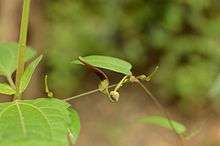Aristolochia indica
| Aristolochia indica | |
|---|---|
| | |
| Scientific classification | |
| Kingdom: | Plantae |
| (unranked): | Angiosperms |
| (unranked): | Magnoliids |
| Order: | Piperales |
| Family: | Aristolochiaceae |
| Genus: | Aristolochia |
| Species: | A. indica |
| Binomial name | |
| Aristolochia indica L. | |
Aristolochia indica is a creeper plant found in Southern India and also Sri Lanka. This plant is critical to the survival of the southern birdwing and common birdwing[1] It reaches a height of several metres on trees and cover the branches with thick foliage. It is commonly found in forest floor, rocky hillslopes. It flowers once a year to produce seeds. It can also be propagated by roots. The plant has a number of historical medicinal uses. This plant contains aristolochic acid is a rodent carcinogen found in Aristolochia and Asarum, both in the Aristolochiaceae family of plants. Aristolochic acid is composed of an about 1:1 mixture of two forms, aristolochic acid I and aristolochic acid II.

In addition to its carcinogenicity, aristolochic acid is also highly nephrotoxic and may be a causative agent in Balkan nephropathy. However, despite these well-documented dangers, aristolochic acid still is present sometimes in herbal remedies (such as for weight loss), primarily because of substitution of innocuous herbs with Aristolochia species. The alcoholic extract is more toxic than the water extract.[2]
References
- ↑ as well as crimson and common rose butterflies. Introduction to the Aristolochiales
- ↑ Michl J., Simmonds M., Ingrouille M., Heinrich M., Toxicological risk assessment of Aristolochia species.. Planta Medica. Conference: 59th International Congress and Annual Meeting of the Society for Medicinal Plant and Natural Product Research Antalya Turkey.
External links
| Wikimedia Commons has media related to Aristolochia indica. |
- GRIN Species Profile
- Anti-inflammatory, Antipruritic and Mast Cell Stabilizing Activity of Aristolochia Indica.
- Toxicological risk assessment of Aristolochia species.